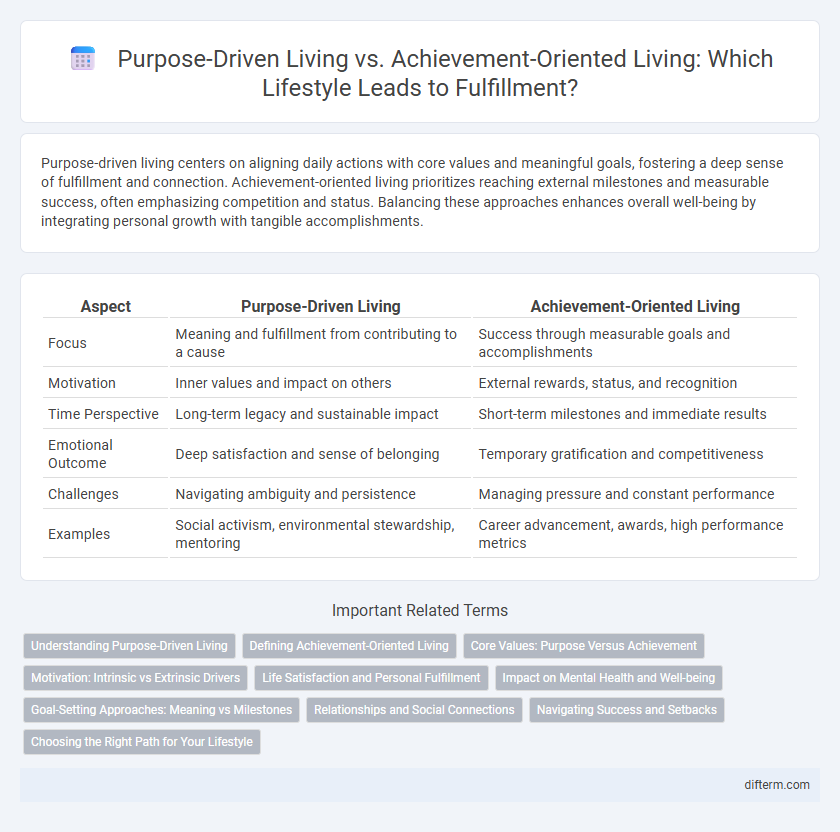Purpose-driven living centers on aligning daily actions with core values and meaningful goals, fostering a deep sense of fulfillment and connection. Achievement-oriented living prioritizes reaching external milestones and measurable success, often emphasizing competition and status. Balancing these approaches enhances overall well-being by integrating personal growth with tangible accomplishments.
Table of Comparison
| Aspect | Purpose-Driven Living | Achievement-Oriented Living |
|---|---|---|
| Focus | Meaning and fulfillment from contributing to a cause | Success through measurable goals and accomplishments |
| Motivation | Inner values and impact on others | External rewards, status, and recognition |
| Time Perspective | Long-term legacy and sustainable impact | Short-term milestones and immediate results |
| Emotional Outcome | Deep satisfaction and sense of belonging | Temporary gratification and competitiveness |
| Challenges | Navigating ambiguity and persistence | Managing pressure and constant performance |
| Examples | Social activism, environmental stewardship, mentoring | Career advancement, awards, high performance metrics |
Understanding Purpose-Driven Living
Purpose-driven living centers on aligning daily actions with core values and long-term meaning, fostering intrinsic motivation and sustained fulfillment. This lifestyle prioritizes personal growth, community impact, and authenticity over external rewards or status. Emphasizing purpose enhances resilience and well-being by creating a clear sense of direction beyond conventional achievements.
Defining Achievement-Oriented Living
Achievement-oriented living centers on setting tangible goals, often measured by external success markers such as career advancements, financial milestones, or accolades. This lifestyle emphasizes productivity, competition, and the pursuit of measurable outcomes as indicators of personal worth and fulfillment. Prioritizing achievement-driven metrics can lead to high motivation but may also result in stress or burnout if balance and intrinsic values are overlooked.
Core Values: Purpose Versus Achievement
Core values in purpose-driven living emphasize meaningful impact, personal fulfillment, and alignment with intrinsic beliefs, while achievement-oriented living centers on measurable success, external validation, and goal completion. Purpose-driven individuals prioritize actions that reflect their ethical standards and contribute to societal well-being, fostering long-term contentment. Achievement-oriented individuals often focus on milestones, rewards, and status, which can sometimes lead to short-term satisfaction but increased stress.
Motivation: Intrinsic vs Extrinsic Drivers
Purpose-driven living is fueled by intrinsic motivation, where personal values and meaningful goals inspire sustained engagement and satisfaction. Achievement-oriented living relies on extrinsic drivers, such as rewards, recognition, and external validation, often leading to short-term motivation but potential burnout. Understanding these motivational differences helps individuals align their lifestyle choices with deeper fulfillment rather than mere accomplishments.
Life Satisfaction and Personal Fulfillment
Purpose-driven living prioritizes aligning daily actions with core values, fostering deeper life satisfaction and a lasting sense of personal fulfillment. In contrast, achievement-oriented living centers on external success and measurable goals, which may lead to temporary satisfaction but often lacks enduring meaning. Research shows individuals embracing purpose-driven approaches report higher well-being and resilience compared to those focusing solely on achievements.
Impact on Mental Health and Well-being
Purpose-driven living fosters a deeper sense of meaning and fulfillment by aligning actions with core values, which significantly reduces stress and enhances overall mental well-being. In contrast, achievement-oriented living often prioritizes external success and perfectionism, increasing anxiety and burnout risks. Emphasizing purpose supports resilience and long-term happiness, while excessive focus on achievements can lead to emotional exhaustion and diminished life satisfaction.
Goal-Setting Approaches: Meaning vs Milestones
Purpose-driven living centers on setting goals aligned with core values and meaningful impact, fostering intrinsic motivation and long-term fulfillment. Achievement-oriented living prioritizes measurable milestones and external validation, emphasizing efficiency and tangible success markers. Balancing meaning and milestones enhances goal-setting strategies, promoting both personal growth and objective progress.
Relationships and Social Connections
Purpose-driven living fosters deeper relationships by emphasizing meaningful social connections and community support, which enhance emotional well-being and resilience. Achievement-oriented living often prioritizes individual success and measurable goals, sometimes at the expense of intimate bonds and long-term social fulfillment. Balancing purposeful engagement with personal accomplishments leads to more robust social networks and sustained happiness.
Navigating Success and Setbacks
Purpose-driven living centers on aligning daily actions with core values and long-term meaning, fostering resilience when facing setbacks. Achievement-oriented living emphasizes measurable goals and external milestones, which can lead to stress and decreased motivation during failures. Navigating success in either lifestyle requires adaptability and self-reflection to maintain balance and personal growth.
Choosing the Right Path for Your Lifestyle
Purpose-driven living centers on aligning daily actions with core values and meaningful goals, fostering long-term fulfillment and emotional well-being. Achievement-oriented living emphasizes setting measurable milestones and external success markers, often leading to rapid progress but potential burnout. Selecting the right path depends on prioritizing intrinsic satisfaction versus tangible accomplishments to create a balanced and sustainable lifestyle.
Purpose-Driven Living vs Achievement-Oriented Living Infographic

 difterm.com
difterm.com